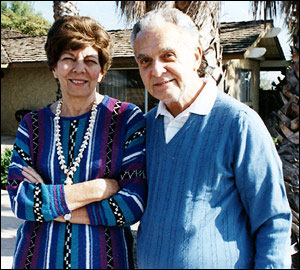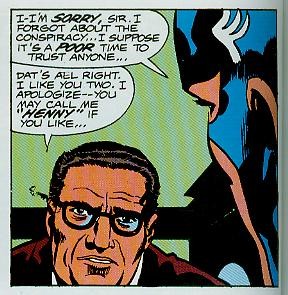Meeting the Kirby’s
by Steve Cohen
 I am glad to say that I was fortunate enough to meet Jack and Roz Kirby in 1987, at The San Diego Comic Con.
I am glad to say that I was fortunate enough to meet Jack and Roz Kirby in 1987, at The San Diego Comic Con.
My long-time friends, Carol Kalish, then in charge of the direct sales division at Marvel Comics, and a big fan of Jack Kirby’s, and Richard Howell, also a Kirby fan, as well as a talented cartoonist-writer-editor and packager of comic book material; and Mark Evanier, well-known biographer, friend, and editorial assistant of Jack Kirby, very kindly arranged for me to attend the by-invitation-only 70th Birthday party for Jack, which was held during the convention weekend, despite being a month before his actual birth anniversary. Along with my then-partner in the comic book retail business, Lou Wysocki, I went shyly in to Jack’s party.
There were so many famous comic book writers, editors, cartoonists, and many animated cartoon makers, and science fiction writers and illustrators there, it was almost overwhelming, but it was a wonderful flurry of activity.
I was standing a short distance away from Jack and Roz, hanging quietly around to see what nuggets of interest I could soak in from the conversations they were having with the various guests, and never expected to actually speak with The Kirbys, but Jack and Roz both made sure that they spoke with everyone who was there. This is my testimonial to the “real” nature of that man: We know that he was an immensely talented. creative force, but, wow, he was so nice to me. When Jack came over to me and asked who I was, I quietly said that I wasn’t “anybody”, well, Jack and Roz would not hear of tis, and told me that “everybody is somebody”. I told The Kirbys that I was a big fan of Jack’s and had been one for over twenty years, and it was just amazing: Jack was so pleased that I had gotten pleasure from looking at the comic books he drew, and he and Roz talked with me for almost a half hour.
I really can’t recall what we specifically talked about, but it was such an uplifting conversation, as I had been feeling “down” prior to the party. After experiencing meeting comic book celebrities many times since 1972, I have to list Jack and Roz Kirby as being among the nicest. To me, Jack will always be “THE KING”, but he was, first and foremost, to use a word he would certainly have been familiar with, a “mensch”.
Thank Goodness I still have the program for that event, it will always be a treasured keepsake.




 Since it is impossible to pick a “favorite” single image or story from Kirby’s vast and brilliant oeuvre, as someone who writes about conspiracies, I feel obliged to draw attention to this aspect of Kirby’s art. Much can be said about the profound impact that the Kennedy assassination had on the artist. Kirby said as much, although Kirby chronicler Mark Evanier, who shuns conspiracies in general, claims not to be able to see it in his work. Suffice it to say that a change does appear in Fantastic Four and the other comics shortly after November 1963. Rather than write that essay, however, I would like to offer Kirby’s 1976 run of CAPTAIN AMERICA to demonstrate that Kirby did indeed have his finger on the pulse of the conspiracy underground.
Since it is impossible to pick a “favorite” single image or story from Kirby’s vast and brilliant oeuvre, as someone who writes about conspiracies, I feel obliged to draw attention to this aspect of Kirby’s art. Much can be said about the profound impact that the Kennedy assassination had on the artist. Kirby said as much, although Kirby chronicler Mark Evanier, who shuns conspiracies in general, claims not to be able to see it in his work. Suffice it to say that a change does appear in Fantastic Four and the other comics shortly after November 1963. Rather than write that essay, however, I would like to offer Kirby’s 1976 run of CAPTAIN AMERICA to demonstrate that Kirby did indeed have his finger on the pulse of the conspiracy underground.  Madbomb involves a mind-control weapon, one that accurately reflected the then emerging “paranoid” complaints of the “wavies”, a large number of American citizens who felt they had been harassed and victimized by directed microwave weapons designed to destroy their minds. After the tumultuous politics of the previous decade, starting with the JFK assassination, many people in America thought they were going crazy and began attributing it to a developing new and secret technology. Kirby imagines this as a weapon of mass destruction, alludes to conspiracy on every page and includes Men In Black and underground bunkers in the “western badlands” in a way that prefigures remarkably the 1980s stories about Area 51 He even includes the master conspiracy bugaboo Henry Kissinger as a character in the tale!
Madbomb involves a mind-control weapon, one that accurately reflected the then emerging “paranoid” complaints of the “wavies”, a large number of American citizens who felt they had been harassed and victimized by directed microwave weapons designed to destroy their minds. After the tumultuous politics of the previous decade, starting with the JFK assassination, many people in America thought they were going crazy and began attributing it to a developing new and secret technology. Kirby imagines this as a weapon of mass destruction, alludes to conspiracy on every page and includes Men In Black and underground bunkers in the “western badlands” in a way that prefigures remarkably the 1980s stories about Area 51 He even includes the master conspiracy bugaboo Henry Kissinger as a character in the tale!